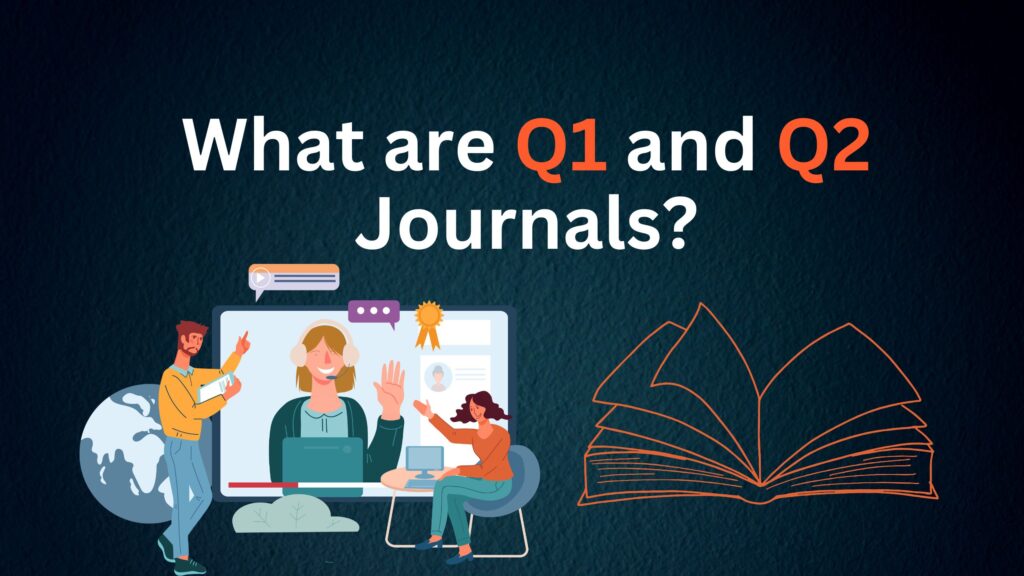What are Q1 and Q2 Journals?

In the academic world, the quality and impact of research publications are often measured by journal rankings. Classification system primarily revolves around the concept of quartiles, with Q1 and Q2 journals playing a significant role in scholarly communication. What Q1 and Q2 journals are, their significance, how they are ranked, and the implications of publishing in these journals for researchers.
What are Q1 and Q2 Journals?
Journals are categorized into quartiles based on their impact factor, which is a measure of how often articles from a journal are cited in a particular period. Breakdown of these quartiles:
- Q1 Journals: Top 25% of journals in a specific field based on their impact factor. Publications in Q1 journals are considered prestigious due to their high visibility and rigorous peer-review process.
- Q2 Journals: Comprise the next 25%, representing the 26th to 50th percentile of journals within a specific discipline. Although they are regarded as slightly less prestigious than Q1 journals, they still provide a platform for quality research and recognition in the academic community.
Importance of Q1 and Q2 Journals
Distinction between Q1 and Q2 journals is critical for several reasons:
- Academic Recognition: Publishing in Q1 and Q2 journals is often a benchmark for academic success. It can enhance a researcher’s CV, aid in securing funding, and contribute positively to tenure reviews.
- Visibility and Reach: Articles in higher-ranked journals are more likely to be read and cited due to the journal’s reputation and reach within academic circles.
- Networking Opportunities: Researchers may have better networking opportunities by publishing in higher-ranked journals, as these journals often host conferences and workshops.
- Research Impact: Higher quartile journals often publish articles that contribute significantly to their respective fields, potentially leading to higher citations and broader influence.
How are Journals Ranked?
Ranking of journals often involves several metrics, with the most prominent being the Impact Factor (IF), calculated annually based on a two-year citation window. However, other factors and indices may also be considered, including:
- h-index: Measures both the productivity and citation impact of the publications.
- Eigenfactor Score: Reflects the total number of citations to a journal’s articles, adjusted for the prestige of the journals where such citations come from.
- Article Influence Score: Calculates a journal’s average influence of its articles over the first five years after publication.
Process of Categorization
- Journal Selection: Journal is selected for analysis based on its inclusion in recognized databases such as Web of Science or SCOPUS.
- Citation Analysis: Total number of citations received by articles published in that journal over a specified time is calculated.
- Impact Factor Calculation: Impact factor is derived by dividing the total citations by the number of articles published in the journal during the same period.
- Quartile Assignment: Journals are then ranked and categorized into quartiles based on their impact factor relative to others in the same field.
Examples of Q1 and Q2 Journals
Q1 Journals
- Nature: Multi-disciplinary scientific journal known for publishing highly influential research.
- The Lancet: Prestigious medical journal that publishes high-impact clinical research.
- Journal of the American Chemical Society: Renowned for its comprehensive coverage of chemistry research.
Q2 Journals
- Environmental Science and Technology: Focuses on research related to environmental science.
- Social Science Research: Publishes articles that contribute to the understanding of social phenomena.
Implications of Publishing in Q1 and Q2 Journals
For Researchers
Publishing in Q1 journals can significantly enhance a researcher’s credibility and authority within their field. It often leads to increased citation rates, greater visibility, and expanded professional networks. Conversely, Q2 journals are still highly respected and can serve as valuable outlets for researchers, especially those early in their careers or exploring niche topics.
For Academic Institutions
Output of research publications in Q1 and Q2 journals is often a key performance indicator for academic institutions. Many universities encourage faculty to publish in high-ranking journals, as it reflects the quality of their research programs and enhances the institution’s reputation.
For Funding Agencies
Funding bodies frequently consider the publication records of researchers when awarding grants. A strong publication profile, particularly in Q1 and Q2 journals, can lead to increased funding opportunities, as it demonstrates the potential impact and relevance of the proposed research.
Challenges in Publishing
Despite their significance, publishing in Q1 or Q2 journals comes with its own set of challenges:
- High Competition: Prestige associated with these journals means that they receive numerous submissions, resulting in a highly competitive selection process.
- Stringent Peer Review: Q1 and Q2 journals typically have rigorous peer-review processes, which can lead to multiple revisions and lengthy publication times.
- Publication Bias: There is an ongoing discussion about publication bias in academia, where studies with positive results are favored over negative or inconclusive results.
Strategies for Success
To successfully publish in Q1 and Q2 journals, researchers can adopt several strategies:
- Select the Right Journal: Carefully choose a journal that aligns with the research topic and audience.
- Follow Submission Guidelines: Adhere strictly to the submission guidelines to increase the chances of acceptance.
- Engage in Collaborative Research: Collaborating with established researchers can enhance the quality of the work and improve publication prospects.
- Stay Updated on Trends: Being aware of current trends within the field can help frame the research in a timely and relevant context.
Q1 and Q2 journals play an important role in the dissemination of knowledge within academia, influencing researcher recognition, funding opportunities, and institutional reputation. Understanding the metrics behind their ranking and the implications of publishing within these journals can empower researchers to navigate the complex landscape of academic publishing effectively.
